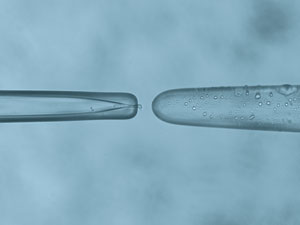The seeing power of frogs

Single photons from a tapered optical fiber (right) are directed at a pipette holding a rod cell taken from a frog’s retina. Reproduced, with permission, from Ref. 1 © 2014 American Physical Society
Miniature light detectors in frog eyes known as retinal rod cells are directly and unambiguously shown to detect single photons of light — an astounding sensitivity considering that a humble 60 watt light bulb spews out a staggering 1020 photons per second. Using a specially developed light source that generates single photons, a new A*STAR study finds that a rod cell has an almost one-in-three chance of detecting an incoming photon.
Scientists have known for some time that rod cells are sensitive to single photons. This was inferred based on statistical modeling in studies that used classical light sources such as lamps, lasers and light-emitting diodes that generate a statistical distribution of photons. In contrast, the light source developed by Leonid Krivitsky and co-workers at the A*STAR Data Storage Institute and A*STAR Institute of Medical Biology is a truly single-photon source and hence eliminates the need to statistically analyze measurement results, thus enhancing measurement accuracy1.
“Our method is both direct and universal,” notes Krivitsky, “as it is not based on any particular statistical model of the cell response and thus does not involve any indirect assumptions.”
In the developed light source, a nonlinear optical crystal is irradiated with light from an ultraviolet laser. Most photons pass directly through the crystal, but approximately one in a million is split into two visible-light photons having twice the wavelength (532 nanometers) of the original photon (266 nanometers). One of these two photons is detected by a photodiode and used to trigger an acousto-optical modulator, causing it to divert the second photon to a tapered optical fiber directed at a pipette containing a rod cell from a frog’s eye (see image). Any signal produced by the rod cell is then detected.
Racing against the clock, since rod cells lose their viability after one to two hours, the researchers measured ten rods cells taken from ten different frogs. They found an average quantum efficiency of approximately 30 per cent — very close to that of human rod cells estimated from behavioral experiments. Krivitsky notes that rod-cell efficiency is comparable to the quantum efficiencies of state-of-the-art man-made single-photon detectors such as photomultipliers (40 per cent) and avalanche photodiodes (50 per cent); remarkably, rod cells occupy an area of only 5 by 50 micrometers and contain their own power supply.
The new light source could be further used to investigate how the quantum efficiency varies with wavelength, since it is easy to vary the wavelength of the generated single photons.
The A*STAR-affiliated researchers contributing to this research are from the Data Storage Institute and the Institute of Medical Biology. More information about the group’s research can be found at the Advanced Concepts & Nanotechnology webpage.
Reference:
[1] Phan, N. M., Cheng, M. F., Bessarab, D. A. & Krivitsky, L. A. Interaction of fixed number of photons with retinal rod cells. Physics Review Letters 112, 213601 (2014).
Associated links
A*STAR article
Media Contact
More Information:
http://www.researchsea.comAll latest news from the category: Physics and Astronomy
This area deals with the fundamental laws and building blocks of nature and how they interact, the properties and the behavior of matter, and research into space and time and their structures.
innovations-report provides in-depth reports and articles on subjects such as astrophysics, laser technologies, nuclear, quantum, particle and solid-state physics, nanotechnologies, planetary research and findings (Mars, Venus) and developments related to the Hubble Telescope.
Newest articles

Properties of new materials for microchips
… can now be measured well. Reseachers of Delft University of Technology demonstrated measuring performance properties of ultrathin silicon membranes. Making ever smaller and more powerful chips requires new ultrathin…

Floating solar’s potential
… to support sustainable development by addressing climate, water, and energy goals holistically. A new study published this week in Nature Energy raises the potential for floating solar photovoltaics (FPV)…

Skyrmions move at record speeds
… a step towards the computing of the future. An international research team led by scientists from the CNRS1 has discovered that the magnetic nanobubbles2 known as skyrmions can be…





















